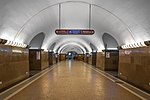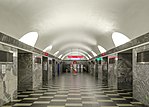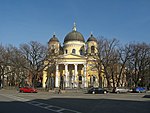Finland Station
1870 establishments in the Russian Empire1960 establishments in the Soviet UnionDemolished buildings and structures in RussiaKarelian IsthmusRailway stations in Russia opened in 1960 ... and 2 more
Railway stations in Saint PetersburgRailway stations in the Russian Empire opened in 1870

St Petersburg–Finlyandsky (Russian: Станция Санкт-Петербург-Финля́ндский Stantsiya Sankt-Peterburg-Finlyandskiy, in spoken language usually just Russian: Финля́ндский вокзал Finlyandskiy vokzal, "Finland Station") (IATA: FVS), is a railway station in St. Petersburg, Russia, handling transport to westerly destinations including Helsinki and Vyborg. The station is most famous for having been the location where Vladimir Lenin returned to Russia from exile in Switzerland on 16 April 1917 (N.S.), ahead of the October Revolution.
Excerpt from the Wikipedia article Finland Station (License: CC BY-SA 3.0, Authors, Images).Finland Station
площадь Ленина, Saint Petersburg Vyborg Side (Финляндский округ)
Geographical coordinates (GPS) Address Website External links Nearby Places Show on map
Geographical coordinates (GPS)
| Latitude | Longitude |
|---|---|
| N 59.955555555556 ° | E 30.356666666667 ° |
Address
Финляндский вокзал
площадь Ленина 6
195009 Saint Petersburg, Vyborg Side (Финляндский округ)
Saint Petersburg, Russia
Open on Google Maps










